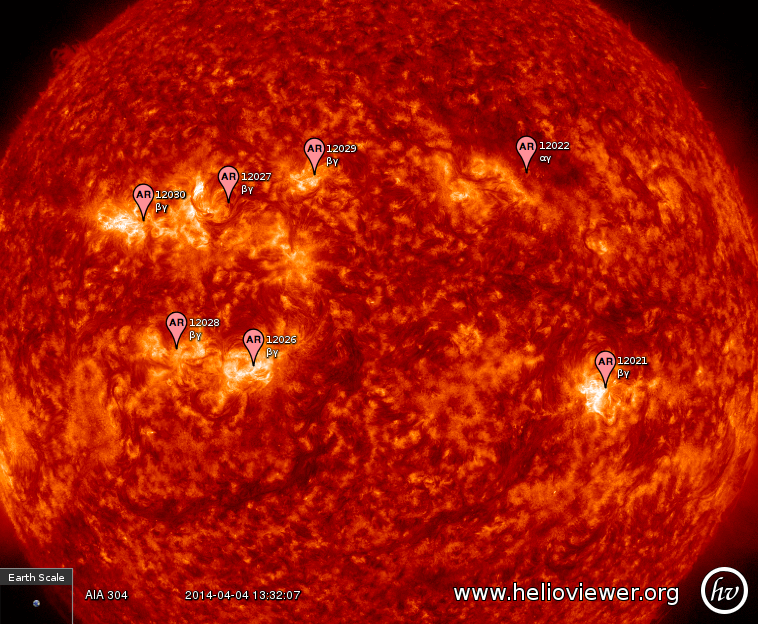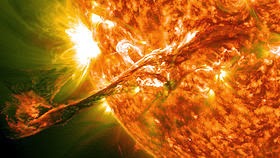| Online: | |
| Visits: | |
| Stories: |

| Story Views | |
| Now: | |
| Last Hour: | |
| Last 24 Hours: | |
| Total: | |
The Sun – The Star of the Solar System
The Sun is the star at the center of the Solar System. It is almost perfectly spherical and consists of hot plasma interwoven with magnetic fields. It has a diameter of about 1,392,684 km (865,374 mi), around 109 times that of Earth, and its mass (1.989×1030 kilograms, approximately 330,000 times the mass of Earth) accounts for about 99.86% of the total mass of the Solar System. Chemically, about three quarters of the Sun's mass consists of hydrogen, while the rest is mostly helium. The remainder (1.69%, which nonetheless equals 5,600 times the mass of Earth) consists of heavier elements, including oxygen, carbon, neon and iron, among others.
The Sun formed about 4.567 billion years ago from the gravitational collapse of a region within a large molecular cloud. Most of the matter gathered in the center, while the rest flattened into an orbiting disk that would become the Solar System. The central mass became increasingly hot and dense, eventually initiating thermonuclear fusion in its core. It is thought that almost all stars form by this process. The Sun is a G-type main-sequence star (G2V) based on spectral class and it is informally designated as a yellow dwarf because its visible radiation is most intense in the yellow-green portion of the spectrum, and although it is actually white in color, from the surface of the Earth it may appear yellow because of atmospheric scattering of blue light. In the spectral class label, G2 indicates its surface temperature, of approximately 5778 K (5505 °C), and V indicates that the Sun, like most stars, is a main-sequence star, and thus generates its energy by nuclear fusion of hydrogen nuclei into helium. In its core, the Sun fuses about 620 million metric tons of hydrogen each second.
Once regarded by astronomers as a small and relatively insignificant star, the Sun is now thought to be brighter than about 85% of the stars in the Milky Way, most of which are red dwarfs. The absolute magnitude of the Sun is +4.83; however, as the star closest to Earth, the Sun is by far the brightest object in the sky with an apparent magnitude of −26.74. This is about 13 billion times brighter than the next brightest star, Sirius, with an apparent magnitude of −1.46. The Sun's hot corona continuously expands in space creating the solar wind, a stream of charged particles that extends to the heliopause at roughly 100 astronomical units. The bubble in the interstellar medium formed by the solar wind, the heliosphere, is the largest continuous structure in the Solar System.
The Sun is currently traveling through the Local Interstellar Cloud (near to the G-cloud) in the Local Bubble zone, within the inner rim of the Orion Arm of the Milky Way. Of the 50 nearest stellar systems within 17 light-years from Earth (the closest being a red dwarf named Proxima Centauri at approximately 4.2 light-years away), the Sun ranks fourth in mass. The Sun orbits the center of the Milky Way at a distance of approximately 24000–26000 light-years from the galactic center, completing one clockwise orbit, as viewed from the galactic north pole, in about 225–250 million years. Since the Milky Way is moving with respect to the cosmic microwave background radiation (CMB) in the direction of the constellation Hydra with a speed of 550 km/s, the Sun's resultant velocity with respect to the CMB is about 370 km/s in the direction of Crater or Leo.
The mean distance of the Sun from the Earth is approximately 1 astronomical unit (about 150,000,000 km; 93,000,000 mi), though the distance varies as the Earth moves from perihelion in January to aphelion in July. At this average distance, light travels from the Sun to Earth in about 8 minutes and 19 seconds. The energy of this sunlight supports almost all life on Earth by photosynthesis, and drives Earth's climate and weather. The enormous effect of the Sun on the Earth has been recognized since prehistoric times, and the Sun has been regarded by some cultures as a deity. An accurate scientific understanding of the Sun developed slowly, and as recently as the 19th century prominent scientists had little knowledge of the Sun's physical composition and source of energy. This understanding is still developing; there are a number of present day anomalies in the Sun's behavior that remain unexplained.
Source: http://stargazernation.blogspot.com/2014/04/the-sun-star-of-solar-system.html






